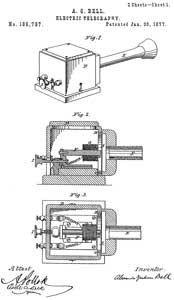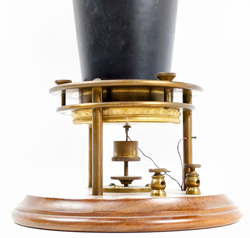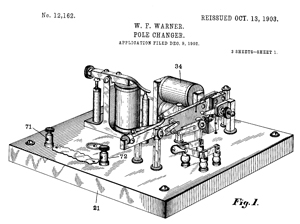Telephone Patents
© Brooke Clarke, N6GCE
2003 - 2024
Magneto
Era
1883 Samuel Morse sends signals over wires
1876 Bell Invents the Telephone
Magneto Ringing Generator
Balance (loading & Induction Coils)
Pole Changers
1880 Handset
1889 Carbon Mike
1893 Better (Long
Pole) Receivers
1891 Dial System working
1892 Carbon Mike
1893 Bell's first patent runs out
1894 Transformer
Mounts
Bakelite
Dials
Design Patents
USPTO Class Numbers
Related
Links
10 Feb 2005 - have replaced all the
patent number links with stable URLs.
5 July 2017 - added a section based on
the book: Electroacuustics: The Analysis of
Transduction, and its Historic Background,
Published by the American Institute of Physics for the
Acoustical Society of America. Frederick V.
Hunt, 1954, 1982, ISBN: 0-88318-401-X
pg 16 - There is a mistake in that the book says the
most important contribution of Joseph Henry was to
sectionalize the electromagnet coil winding into
sections. But that's far from the case.
The KEY thing Henry did was to insulate the wire he
used. All prior work with electromagnets used
bare wire. Henry used his wife's spinning wheel
to cover "Bell" wire with silk. Note "Bell" wire
was not the name for electrical wire used to ring
doorbells as it is so named today, but rather it was
wire that was routed using pulleys mechanically
terminated in bells that rang when the master pulled a
cord, hence "bell wire".
pg 23 - 174465
Telegraphy, A. G. Bell March 7, 1876 379/167.01;
178/48
-
pg 33 - 186787
Electric Telegraphy A. G. Bell Jan 30, 1877
379/167.01; 379/387.01;
381/177
- includes use of permanent magnet for receiver
pg 34 - Francis Blake carbon transmitters with
Berliner induction coil competes with Edison carbon
mike
250126
Speaking-telephone, Francis
Blake, sold to Bel Tel, Filed: Sep
15, 1881 Pub: Nov 29, 1881, 381/179; 381/347 -
had a stability problem
250127
Speaking-telephone, Feancis
Blake, sold to Bel Tel,
Filed: Sep 15, 1881
Pub: Nov 29, 1881, 381/179 - had a stability
problem
250128
Speaking-telephone, Feancis
Blake, sold to Bel Tel,
Filed: Sep 15, 1881
Pub: Nov 29, 1881, 381/178 - had a stability
problem
225790
Microphone, Emile Berliner, Mar 23, 1880, 381/354;
381/180 - pendulous weight = not at all practical, no
induction coil
234744
Microphone, Emile Berliner, Nov 23, 1880, 381/178
- couples microphone to induction coil to
transform impedance, can be used by Bel Tel with Blake
carbon mike patents.
463569
Combined Telegraph and Telephone, Emile Berliner,
Filed: Jun 4, 1877 (14 year delay) Pub: Nov 17, 1891,
381/178 -
|
Magneto Era
YouTube: PhoneCoInc: Magneto Era (1876-1900), 32:56 covers
this time frame with examples of all the key inventions.
Prior to the invention of the telephone the only means of
electrical communication was the telegraph.
1833 Samuel Morse
sends signals over wires
For about 40 years the telegraph
was THE way to send a message quickly. Bell was working on a
way to allow multiple messages to be sent in parallel over a
single wire by using different audio frequencies for each
message. Today it would be called FDMA, Frequency
Division Multiple Access. In the process he realized
that voice could be sent over a wire. This required the
invention of the microphone and the invention of the
speaker. The device in the bell patent works as both a
microphone and a speaker.
See the Leclanché Battery web
page for those and related patents.
See the Gamewell Fire Alarm Street Box for more on Pen Registers.
Related Telegraph Patent
166095
Electrical
Telegraph for Transmitting Musical Tones, Elisha Gray, July
27, 1875
178/47
Note that the Gray patent title is Electrical Telegraph for
Transmitting Musical Tones not some new term to describe
telephony. Gray thought he had a patent on an
improvement to telegraphy. The single class number is
178/47 which is for Telegraphy/Harmonic or reed.
1876 Bell Invents the
Telephone
Magneto Era @1:48,
@ 2:33 The
Gallows Telephone,
@3:11 Liquid
Transmitter (I have not found a patent for the liquid
transmitter),
@4:38
Centennial Transmitter,
@5:01
Centennial Iron Box Receiver,
@5:14 Box
Telephone & Watson's mechanical thumper (incoming call
noise),
@6:20
Butterstamp (prior to long pole) Design,
First generation Local Battery operation with hand crank
generator signaling.
174465
Telegraphy, A. G. Bell March 7, 1876
379/167.01;
178/48
- sending sounds over wire "The most valuable patent ever issued"
Included in this patent are the
Gallows and Liquid phones. Both are combined dynamic
microphone/earphone types.
The primary class number 379/167.01 is for Telephonic
Communications/
Private (e.g., house or intercom) or
Single Line System.
The secondary class number 178/48 is for Telegraphy/Harmonic or
reed/Recorders and receivers
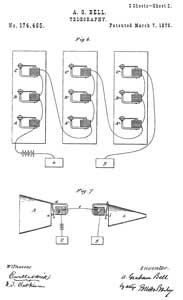
|
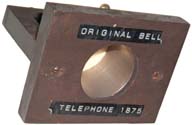
|
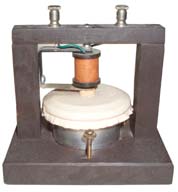
|
sheet 2 of patent figures
Fig 6: the 3 "A" reeds vibrate in unison, &Etc.
Fig 7: Voice not tones
|
Gallows
Phone
Mouthpiece
|
Side
(Gallows)
view
|
Is patent 174465 also the first patent for a speaker - earphone
type device? yes.
Note that the coil and terminals looks just like those used in
telegraphic
sounders.
For more on this phone, see my
phones
web page.
Remember that at the time the patent titles were commonly the same
for the same patent class. For example out of over 400
patents related to the stock ticker machines the vast majority of
them are titled "Printing Telegraph". Since patent class 379
to telephone related inventions did not exist then the only class
that mase sense with 178 for Telegraph Equipment. So
although it looks strange today to see "Telegraph" as the title on
a patent for the telephone, at the time it was about the only
choice.
Other Patents
199141
Telephone, E. Berliner, Jan. 15, 1878
379/167.01;
379/391;
381/178
201488
Speaking Telephone, A.G. Bell, March 19, 1878 381/163 ; 335/231;
336/110; 336/211; 381/419 -
this is the oldest patent in class
336/110 Inductor Devices/using a permanent magnet
The main idea is to close the magnetic
path so that there is only the gap to the diaphragm.
203013
Speaking-Telegraph, T.A. Edison, April 30, 1878 381/111; 381/179
203016
Speaking-Telegraph,
T.A. Edison, April 30, 1878 379/373.01
210886
Polarized Armature for Electric Bells, T. A. Watson, Dec. 17, 1878
340/397.5
485311
Telephone,
Anthony
C. White (
Wiki),
American
Bell Telephone Co, 1982-11-01-
Magneto Ringing Generator
@8:30 Magneto
Era: Signaling, @8:54 Leclanché Battery, @9:30 Williams Coffin (Wood, wall mount, bells, two
long poles, crank on front, magneto or bell switch & Lightening protection),
@9:46 Gravity
(Hook Switch for magneto-Bell)

|
202495 Telephone Call-Signal
apparatus, T. A. Watson, April 16, 1878 379/373.01; 74/47
- Magneto & ringer
This was the start of magneto signaling but it had some
problems.
1. The switch needs to be set to "Bell" (position 1) after
all calls so someone can call you. If you forget all
is lost.
2. Cranking the magneto at a 1:1 ratio requires a LOT of
work.
|

|
217849
magneto-electric
call apparatus, George
L. Anders, Jul 29, 1879, 310/75B
- magneto generator (4 horseshoe magnets)
Uses a special pulley system to gear up the magneto
solving problem 2 above.
|
|
223132
Automatic Electric-switch for Telephones, E.T. Greenfield,
1879-12-30, - switch in end of long pole receiver.
For switching the talk circuit, I don't think for the bell
circuit.
330064
Gravity Telephone Switch, C. E. Scribner, Western
Electric, 1885-11-10, 379/424 -
This is a follow on patent to 271280 for a secrecy switch.
to replace magneto-bell switch have not found patent by
Hilborne Roousvelt for his gravity switch.
|

|
273714
Magneto-electric signaling apparatus, T.A. Edison,
1883-03-13, -
The magneto is automatically switched into and out of the
circuit by means of turning the hand crank.
has what became common gearing (c & d) of hand crank
to magneto.
This solves both of the problems with the Watson patent
above.
|
Unknown Magneto generator, missing the magnets. Where would
they go? Is red bar supposed to be a magnet?
66A stamped on top of cast iron pole
with a 6 on either side of the hole at the top
Note only one hole at top of this pole.

|
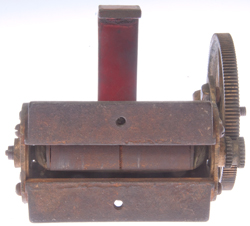
|
3 holes on top of front pole.
Output is between case and shaft at center.

|
Balance (loading & Induction
Coils)
The early telephone lines consisted of a single wire (to save
money) and a ground return. But the mutual inductance
between wires caused crosstalk (Wiki).
As the number of wires and active circuits grew this became a
large problem. Also see: Inductors: 88mH, Induction Coil
232788
Thomas A. Watson, Sep 28, 1880, 379/240 - periodically a
transformer is used to interchange the ground and aerial side of
the circuit. The idea of running a separate ground wire
near the aerial wire to cancel the crosstalk was know but viewed
as too expensive.
This lead to the induction coil and balanced cables.
705936
Loaded electric circuit,
John C
Lee,
Edwin
H Colpitts,
AT&T,
1902-07-29, -
720023
Electric cable,
Roderic
F Hall,
WE,
1903-02-10,
174/27; 174/116-
792248
Induction-coil,
George
A Campbell,
AT&T,
1905-06-13,
336/84C; 333/25; 336/84R; 336/69; 336/107;
379/387.01 -
980921
Loaded phantom-circuit,
George
A Campbell,
Thomas
Shaw,
AT&T,
1911-01-10, -
1133750
Transformer,
Thomas
Shaw,
AT&T,
1915-03-30, - Phantom Circuit
1174187
Loading-coil,
Thomas
Shaw,
AT&T,
1916-03-07, - Duplex Phantom Circuit
1251651
Core for magnetic coils,
Lloyd
Espenschied,
AT&T,
1918-01-01, -
1727971
Electrical cable,
Ford
Leroy Stearns,
WE,
1929-09-10,
174/112; 156/55; 174/113R; 57/210; 156/56-
Pole Changers
Manual telephone exchanges used electric bells as a way to get
someone's attention. These required AC at about 10 Hertz
(then called Cycles Per Second or CPS).
The "pole changer" was a device that converted a DC battery
voltage into AC ringing voltage.
238263
Pole-Changer for Telephone-Exchanges, E.P. Warner (Western
Electric Mfg Co), Mar 1, 1881, 361/246
685887 Pole
Changer, W.F. Warner (Warner Elec Co), Nov 5, 1901, 361/246 -
RE12162 Pole
Changer, W.F. Warner (Warner Elec Co), Oct 13, 1903, 361/246 -
1067527
Signaling System, C.A. Larson (Kellog Switchboard & Supply
Co), Jul 15, 1913, 379/186
1330059
Pole Changer, H.D. Currier (Kellog Switchboard & Supply Co),
Feb 10, 1920, 379/181; 340/328; 340/331; 340/333 -
1382745
Electrical Rectifier and Pole Changer, F. Schoenwolf (Kellog
Switchboard & Supply Co), Jun 28, 1921, 363/34; 379/418
1879 to 1890 Attempts at dial systems
215837 Telephone Switch May 27, 1879, H.L. Rosevelt 379/426
222458
Automatic Telephone Exchange Dec 9, 1879 M D & T A Connolly
and T J McTighe 379/195
- dial system that did/tn work
258626
Individual Signaling Aparatus for Telephone Systems May 30, 1882 C
E Buell (US Tel Mfg Co) 340/825.41;
379/177;
379/302
- early try at dial phone
275296
Automatic Signaling Aparatus for Telephone Circuits Apr 3, 1883 T
N Vail 379/302; 341/192
- try that did not work for dial phone
1889 Carbon Mike
The Bell System Technical Journal, April 1934 - The Carbon
Microphone: An Account of Some Researches Bearing on Its Action.
(Bell-1934b.o.pdf)
Open-Wire Crosstalk
Appendix: Calculation of Crosstalk Coefficients
Symposium on Wire Transmission of Symphonic Music and Its
Reproduction in Auditory Perspective, Basic Requirements
Physical Factors - good perspective and be obtained with only 2
or 3 channels
Loud Speakers and Microphones - for music
Amplifiers - for music
Transmission Lines - for music
System Adaptation - for music
Abstracts
The Bell System Technical Journal, April 1924 (Bell-1924b.o.pdf)
An Electrical Frequency Analyzer - "Record of
160-cycle Buzzer Output
Magneto Era @9:57 Edison
Carbon Mike "Transmitter" (see 406567 below), @16:08 White
Transmitter Design "White Solid Back" on most US candlesticks in
1920,
246512
Transmitter for Telephones, H. Hunnings, American Bell Telephone
Co., Aug 30, 1881, 381/180 - carbon powder
250250
Telephone Transmitter, H. Hunnings, American Bell Telephone Co.,
Nov 29, 1881, 381/180 - carbon particles
250126 Speaking-telephone, Francis
Blake, sold to Bel Tel, Filed: Sep 15,
1881 Pub: Nov 29, 1881, 381/179; 381/347 - had a stability
problem
250127 Speaking-telephone, Feancis
Blake, sold to Bel Tel, Filed:
Sep 15, 1881 Pub: Nov 29, 1881, 381/179 -
had a stability problem
250128 Speaking-telephone, Feancis
Blake, sold to Bel Tel, Filed:
Sep 15, 1881 Pub: Nov 29, 1881, 381/178 -
had a stability problem
225790
Microphone, Emile Berliner, Mar 23, 1880, 381/354; 381/180
- pendulous weight = not at all practical, no induction coil
234744
Microphone, Emile Berliner, Nov 23, 1880, 381/178 -
couples microphone to induction coil to transform impedance, can
be used by Bel Tel with Blake carbon mike patents.
463569
Combined Telegraph and Telephone, Emile Berliner, Filed: Jun 4,
1877 (14 year delay) Pub: Nov 17, 1891, 381/178 -
406567
Telephone T. A. Edison July 9, 1889
381/180;
252/502
- uses carbon-granules. When combined with the Induction
Coil provides a lot of gain.
AGB's patent 174465 was for a combined dynamic microphone -
earphone - speaker device. But the granular carbon mike was
the common microphone used through the 1950s for telephones,
military radios, and many other microphone applications.
From 1950 to the present military radios use dynamic mikes.
Henry Hunnings patented a similar system in 1881 in the UK?
474230 Speaking-telepgraph, Thomas
A Edison, WU
Telegraph Co. Filed:Apr 27, 1877 Pub: May
3, 1892,
381/177 -
474231
Speaking Telegraph,
Thomas
A Edison, WU
Telegraph Co., Filed:Apr
27, 1877 Pub: May 3, 1892,
381/179 -
474232 Speaking
Telegraph,
Thomas
A Edison, WU
Telegraph Co., Filed:Apr
27, 1877 Pub: May 3, 1892,
381/179 -
485311
Telephone,
Anthony
C White,
American
Bell Tel, 1892-11-01, - hermetically sealed carbon granul
case.
1891 Dial System working
Second generation system using
Common Battery signaling, and sometimes common battery power for
the carbon mike.
447918
Automatic Telephone Exchange March 10, 1891 A. B. Strowger
379/302
this
is the class for dial systems
449106
Telephone Circuit and Aparatus, J. J. Carty, Mar. 31, 1891
379/177
1892 Carbon Mike &
Strowger
474230
Speaking-Telegraph,
Thomas Edison, May 3, 1892
381/177
Web
page devoted to this
carbon
type transmitter, a patent that took 15 years to grant.
485311
Telephone, A. C. White Nov. 1, 1892
381/180
- Granular Button Transmitter element assigned to American
Bell Telephone
486909
Automatic Telephone or other Electrical Exchange, A.B. Strowger,
1892-11-29, 335/111 -
Better (Long Pole) Receivers
Magneto Era: @16:36 Long Pole
Receivers, WE: Outside Terminal Receivers, @17:58
Phelps Crown Receivers (multi-pole) (not finding any US patents),
@18:30 Pony
Crown, @18:39 Gower
Receiver ("D" magnet with gap in straight part), @23:15 Gower Bell
telephone (2 listening tubes), 23:53 Hughes
Telephone, 24:27 American
Triple Box Design, @25:15 Twin Box, @28:34 WE Swing
Arm Desk Phone, @29:23 Ericsson
Skeletal, @29:52 UK WE
Eiffel Tower, @30:20 B.P.O.
Skeletal Design, @31:15 American
Dest Stand aka: Candlestick,
Wood Wall Phone Patent Dates (was American Bell Telephone,
Triple Box )
Type 21 Patented: Oct 31, 1882; Dec 23, 1884; Nov 16, 1886, Apr 8,
1890; Mar 31, 1891; Jul 11, 1893
Type 44 Patented: Apr 8, 1890; Jul 11, 1893
Type 72 Patented: Nov 9, 1886; Mar 3, 1891; July 4 or 11, 1893;
July 17, 1894; Mar 3, 1896
Type 72 Patented: Oct 31, 1882, Dec 23, 1884; Nov 16, 1886;, Apr
8, 1890; Jul 11, 1898
Type?? Patented: Apr 16, 1878; Dec 17, 1878; May 17, 1879; Nov 11,
1879; American Bell Tel
Type?? Patented: APRIL 16, 1878; DEC 17, 1878; JULY 30, 1879; PAT
NOV 11, 1879
No. 4 top box Patented: APR 6 1878; JAN 8 1883
Type?? Patented: APRIL 16, 1878, DEC 17, 1878, MAY 27,1879, NOV
11, 1879, AUG 31, 1880, JULY 20, 1880, JAN 9 1883, DEC 28, 1884
507728
Telephone, S.D. Field, American Bell Tel,1893-10-31, - looks like
the right angle drive used on Sound Powered Phones (much more
efficient)
540969
Telephone, S.D. Field, American Bell Tel, 1895-06-11, -
575394
Magneto-telephone, S.D. Field, American Bell Tel, 1897-01-19, -
external terminals and central screw that holds horseshoe magnet
833279
Telephone-receiver, Henry
F Albright, Western
Electric (AT&T), 1906-10-16, 381/417 -
tubular long pole magnet and metal case (rubber has different
thermal expansion than magnet, so prior art rubber case units have
problem.)
1893
Bell's first patent runs out
529421
Multiple Switchboard System Nov 20, 1894 C. E. Scribner
379/319;
379/313;
379/332
545416
Telephone Aug 27, 1895 G F Shaver
379/350
- new carbon mike and improved wiring
570840
Automatic Telephone System Morgan Brooks Nov 3, 1896
379/215.01;
340/298;
340/313;
379/258
597062
Calling Device for Telephone Exchanges, A. E. Keith & C. J.
Erickson, Jan. 11, 1898
379/365;
340/294;
379/367
assigned to the Strowger Automatic Telephone
Exchange, replaced the origional buttons with a dial, this is the
first patent in class 379/367
670564
Telephone Receiver, C. H. North, March 26, 1901
381/393
- has internal terminals
687499
Telephone Transmitter (Candlestick), Nov 26, 1901, WW Dean,
Kellogg,
381/180 ;
381/186;
381/347
- preventing carbon granules from compacting. (found this
while looking for patent
112158
which is not a Kellogg phone patent)
815176
AutomaticTelephone Connector Switch March 13, 1906 A E Keith &
C J Erickson (AE Co) 379/302; 379/303 - modern step &
repeat switch, 26 page patent, very complex switch
with many parts
815321
AutomaticTelephone Connector Switch March 13, 1906 A E Keith &
C J Erickson (AE Co)
335/109; 74/21; 74/156; 74/169;
74/575; 379/302 - more on the step & repeat switch
831875
Interrupter for Automatic Telephone or other switches Sep 25, 1906
A E Keith (AE Co) 379/302; 379/337
848398
Automatic
Exchange Selector March 26, 1907 J G Roberts (WE Co) 379/302;
335/136; 340/825.4
1050304
Telephone-transmitter,
Charles E Scribner,
Western
Electric,1913-01-14, - carbon mike with cone mouthpiece,
like on wooden phone, or candlestick.
1508424
Telephone Desk Set Sep 16, 1924 G. K. Thompson (AT&T)
379/424;
379/436;
379/454
- dial phone with cradle for handset
1565581
Telephone Transmitter, C. H. Moore, Dec. 15, 1925
381/180
Not position sensitive
1602824
Telephone Receiver, L L Jones
381/419 ; 310/25;
367/182
1615311
Impulse Sending Device Jan 25, 1927 H. F. Obergfell
(Automatic Electric)
341/184; 379/366 - rotary dial
1642822
Calling Device Sep 20, 1927 H. F. Obergfell (Automatic
Electric)
379/367; 379/369 - rotary dial
1719992
Calling Device July 9, 1929 H. F. Obergfell (Automatic
Electric)
379/362; 379/367
1894 Transformer & RR
Call Box
|
519346
Apparatus for telegraphic or telephonic transmission,
Idvorsky Pupin Michael, 1894-05-08
519347
Transformer for Telegraphic, Telephonic or other
Electrical Systems, M I Pupin,
May 8, 1894, 379/398
; 307/109; 333/177; 333/27; 336/182
This patent purchased by Bell Telephone in 1901 |

|
523132
Magneto Call-Box, Charles
E. Scribner, Western
Electric, 1894-07-17 - Long Island Rail Road Co. |
Mounts
See: Western Electric
Candlestick Dial Telephone
769702
1904-09-13 App 1903-06-06; Lattig & Goodrum (), Telephone
Transmitter
1125965
Automatic switching system, Edgar H Clark, Western Electric Co
Inc, 1915-01-26 App 1908-01-20;
1125997
Selective signaling system, Joseph C Field, Western Electric Co
Inc, 1915-01-26 App 1912-08-23
1251995
Telephone desk-stand, Oscar F Forsberg, Western Electric Co
Inc, 1918-01-01 - WE 50AL Telephone Desk Stand
1124021
Impulse-transmitter, William F Hoffmann, Western Electric Co Inc
1161854
Calling Device, O.F. Forsberg, Western Electric Co Inc, Nov 30,
1915, 379/366; 188/184; 379/367 - WE Type D-8083 Dial
1251995
Telephone desk-stand, Oscar F Forsberg , Western
Electric Co Inc, 1918-01-01 - WE 50AL Telephone Desk Stand
D52010
Desk Telephone Stand, O.F. Forsberg, Western Electric Co Inc,
May 7, 1918, - WE 50AL Telephone Desk Stand
1353612
Telephone Exchange System, F.N. Reeves, Sept 21, 1920 - 50AL
dial wiring for candlestick phone
1456501
Desk stand for hand telephones Images, Omer M Glunt, Western
Electric, 1923-05-29, -
Bakelite (Wiki)
Started looking for a replacement for shellac (Wiki) and
announced Bakelite in 1909.
Patents by Leo
H. Baekeland.
Dials
1030412
Impulse-transmitter, Jacob
W Lattig, American
Automatic Telephone Co, 1912-06-25, 379/362 -
Design Patents
D14/149
& D14/153 & D14/248
D23825
Transmitter-post for telephones, William
Gray, Nov 27, 1894 D14/149 -
microphone only
D24175
Telephone-support, Apr 2, 1895 D14/149 -
D30794
Base and casing for portable telephones, Benjamin
Le Vino, May 16,, 1899 D14/153 -
D32527
Telephone-standard, Apr 17, 1900 D14/149 -
D41616
Telephone desk-stand, William
W. Bean, Jul 25, 1911 D14/149 -
microphone only
D41794
Telephone desk-stand, John G. Blessing, Sep 19, 1911 D14/153 -
D43173
Bottle, George
R. West, Oct 15, 1912 D9/600; 446/141; D14/149- microphone
& long pole receiver whiskey bottle
D52010
Desk Telephone Stand, Oscar F. Forsberg, May 7, 1918, D14/153 -
D57700
Desk-stand for hand-telephones, Ernest
S. Mclarn, Apr 26, 1921, D14/153 -
D57701
Desk-stand for hand-telephones, Ernest
S. Mclarn, Apr 26, 1921, D14/153 -
D65204
Design for a desk stand for hand telephones, George
K. Thompson, American
Tele, Jul 15, 1924 D14/149 - A1
Mount design
D68929
Combined ringer box and telephone desk stand, Herbert F.
Obergfell, Dec 1, 1925, D14/153 379/436 -
D74188
Telephone Desk Stand, H.F. Obergfell, Jan 3, 1928 - center plunger
hook switch, fork type support D14/149 - Type A
desk stand
D78605
Telephone desk stand, Henry
Melvin Bascom, May 28, 1929, D14/153 -
D80670
Desk stand for a hand telephone, Nelson Blount, Mar 11, 1930 -
D80671
Desk stand for a hand telephone, Nelson Blount, Mar 11, 1930 -
D80672
Desk stand for a hand telephone, Nelson
Blount, Mar 11, 1930 -
D81476
Desk stand for a hand telephone, Rene
Clarke, Jul 1, 1930, D14/153 -
D81510
Desk stand for a hand telephone, John
Vassos, Jul 1, 1930, D14/153 -
D81511
Hand telephone, John
Vassos, Jul 1, 1930, D14/248 -
D81512
Desk stand for a hand telephone, John
Vassos, D14/248 -
D81513
Hand telephone, John
Vassos, Jul 1, 1930, D14/153 -
D81562
Desk stand for a hand telephone, John
Vassos, Jul 8, 1930, D14/153 -
D81680
Desk stand for a hand telephone, Lttcian Bernhard, Jul 29, 1930, D14/153 -
D82414
Desk stand for a hand telephone, Lttcian Bernhard, Nov 4, 1930, D14/153 -
D83514
Telephone desk stand, George
B. Eaton, KELLOGG
SWITCHBOARD a SUPPLY CO, Mar 3, 1931 D14/149 - center plunger hook switch, depressions
for transmitter & receiver
D83515 Telephone desk stand, George
B. Eaton, KELLOGG
SWITCHBOARD a SUPPLY CO, Mar 3, 1931 D14/153 - center plunger hook switch, depressions
for transmitter & receiver
D86263
Telephone desk stand, H.F. Obergfell, Feb 16, 1932 D14/153 - AE 34 desk stand
D88804
Desk stand for a hand telephone, George R. Lum, Dec 27, 1932, D14/153 -
1971499
Telephone handset, Herbert F Obergfell, 1934-08-28, 381/344; 381/391 -
2008287
Telephone substation apparatus, George
R Lum, Bell
Labs, Jly 7, 1935, 379/424 D14/153 379/436 379/437 -
2019601
Telephone substation apparatus, William
A Evans, Nov 11, 1935, 379/436 D14/153 -
D92442
Telephone instrument, Everett
Worthington, Jun 5, 1934 - center plunger hook switch, fork
type support, spit cup transmitter, place for dial
D94158
Wall telephone, Herbert
F. Obergfell, Dec 25. 1934 - AE 35 wall telephone
D95765 Desk
stand for a hand, George
R. Lum, May 28, 1935 - Bell System
302
D104087
Telephone desk stand, Henry
E. Billington, Kellogg
Switchboard a Supply Company, Apr 13, 1937 - art deco
D106322
Telephone Handset Mounting, M. L. Nelson,, Oct 5, 1937, D14/153 -
D106457
Combined Telephone Desk Stand and Handset, R.F. Stehlik, Oct 12,
1937, D14/153 -
2127569
Desk telephone, Herbert
F Obergfell, Associated
Elec Labs, Aug 23, 1938, 379/352 379/427 D14/153 379/436 -
D108022
Design for a telephone hand-set, Hans
Sengebuseh, Jan 18, 1938, D14/153 -
D109123
Combined Hand Telephone and Stand therefor, H.
Bergman, Apr 5, 1938, D14/153 -
D109648
Telephone cabinet, Theodore
N. Saaty, The
Screw Machine Products Corporation, executive desk control
with buttons on front panel and a couple of speakers
D117876
Telephone desk stand, H. F. Obergfell, Nov 28, 1939, D14/153 -
2296846
Telephone calling dial, Harold
W Goff, Bell Labs, Sep 29, 1942, 362/23.06 362/23.01 D14/153 362/274 379/367
362/602 -
D132902
Stand for a hand telephone, Jack
Barofsky, Jun 30, 1942 - art deco
D135389
Loud-speaking telephone, Gabriel
M. Giannini, Mar 30, 1943 D14/153 379/432 - with dial but no
handset
D135401
Loud-speaking telephone, Gabriel
M. Giannini, Mar 30, 1943 D14/153 379/432 - with dial but no
handset
D135495
Loud-speaking telephone, Gabriel
M. Giannini, Apr 13, 1943 D14/153 379/432 - with dial but no
handset
2338757
Telephone set, Stanley
T Curran, Bell Labs, Jan 11, 1944, 379/423 D14/153 200/314 - 302 with 6 buttons?
2364771
Telephone signaling system, Henry
M Bascom, Francis
A Hubbard, Bell
Labs, Dec 12, 1944, 379/171
340-12.12 379/364 341/20 D14/153 - 302 with 15 buttons
D140904
Combined telephone desk stand and hand set, Gerald
Deakin, Apr 17, 1945, D14/153 379/436 379/368 - 0 to 9 push
buttons facing up AND a dial
D141425
Combined telephone desk stand and handset, Edward
F. Mckenna, May 29, 1945, D14/153 379/454 -
D141641
Convertible desk and wall telephone set, Max
G. Kolmes, Internanational
Standard Electric Corp., Jun 19, 1945 - with optional hand
crank
D144130
substation telephone instrument, Herbert
F. Obergfell, Mar 12, 1946, , D14/153 - dial
& hand crank
D144674
Stand for a Hand Telephone, Jack
Barofsky, May 14, 1946, D14/153 -
2428593
Telephone substation set, Walter
D Teague, Jr
Walter D Teague, Kellogg
Switchboard and Supply, Oct 7, 1947, 379/424 D14/153 379/436 -
D151121
Erickson telephone desk unit, Clifford
E. Erickson, Kellogg
Switchboard & Supply CO., Sep 28, 1948 -
2479198
Telephone instrument, Baker
George Thomas, Automatic
Electric Lab, Aug 16, 1949, 379/433.01 D14/153 379/434 - sort of trim line
with spit cup
2487013
Portable radio receiver, Frank
A Zibelman, Nov 1, 1949, 455/149 D14/153
312/7.1 455/175.1 455/350 - AM radio built into 302 case
D153927
Desk Stand for a Hand Telephone, Henry Dreyfuss, Robert H. Hose,
Bell Telephone Labs, May 31, 1949, D14/149 - Bell System 500 Calls D95765 &
D151121
D153928
Desk Stand for a Hand Telephone, Henry Dreyfuss, Robert H. Hose,
Bell Telephone Labs, May 31, 1949, D14/153 - Bell System 500
D159188
Telephone Set, Hiram
D. Currier, Leich
Electric
Company, Jul 4, 1950 - a 302 telephone with the dial
replaced by a hand crank?
D210776 , D210777
Telephone stand, Henry
Dreyfuss, Bell Telephone Labs, Nov 19, 1957 - Princess
Newer Patents
1061813
Telephony, Sidney
George Brown, 1913-05-13, - using carbon mike as amplifier
- YouTube AWA: A 100
Year Old Solid-state Amp - The Brown Microphone Amplifier,
23:20 -
2443329
Telephone handset bracket, Sterling
G Sears, 1948-06-15, - on the "bracket": ROANWELL, U.S.
Pat. No. 2443329 - on red crypto wall phone: TA-840A/U,
Telephone Set, 24VDC 150 mA, PT 28687 - 74E10N100
2567812
Code transmitter, Clarence
N Hickman, Bell Labs, 1951-09-11, - AC signaling has
advantages over DC signaling. Telephone set with 4x2 tone
keyboard.
3627930
Dial-in-handset telephone assembly, Warren R Tolman, AT&T,
1971-12-14 - Trimline (Wiki)
4823379
Telephone ringer 379/373.01 ; 340/397.5 - This is an example of
something that looks like a good idea. BUT . . . the way
it's been manufactured it's so fragile that age or dropping the
phone breaks the plastic parts. So professional phone
installers avoid any phone that contains this ringer like the
plague.
Cross Bar Switch replaces the Step and Repeat Switch
Third generation switching, didn't
last that long
Electronic Switch replaces the Cross Bar switch
Forth generation, and now current,
switching.
USPTO Classification Numbers Relating to
"Telephone"
Telephone .................................. 379
Answering device
Answering-recording system ......... D14 / 141
Calling number recorder ............ 379 / 142.01+
Remote inquiry ..................... 379 / 76
Sound recorder or reproducer ....... 379 / 70+
Attachment ............................. 379 / 441+
Base pad ........................... 248
Index .............................. 40 / 336+
Pad ................................ 281 / 44
Roll type pad ...................... 281 / 11
Automatic systems ...................... 379 / 258+
Call ............................... 379 / 350+
With recorded message .......... 379 / 69
Card ............................... 40 / 336+
Common control ..................... 379 / 268
Party line ......................... 379 / 182+
Booths ................................. 52 / 27+
Design ............................. D25 / 16
Movable wall ....................... 52 / 71
Calling ................................ 379 / 352+
Card attached to telephone ............. 40 / 336+
Cellular or zoned radiotelephone ....... 455 / 422.1+
Coin collectors for pay stations ....... 194
Coin operated .......................... 379 / 143+
Computerized switching ................. 379 / 284
Cordless ............................... 455 / 462+
Design ................................. D14 / 142+
Dial
Dial structure ..................... 379 / 362+
Illuminated ........................ 362 / 24
Locking ............................ 379 / 445
Pulse transmitter .................. 379 / 362+
Self luminous ...................... 40 / 337
Telephone system ................... 379 / 258
Directory .............................. 40 / 371
Earth transmission ..................... 455 / 40
Handset ................................ 379 / 433.01+
Headgear support ....................... 379 / 430
Key systems ............................ 379 / 156+
Light wave telephony ................... 398 / 132+
Lights for telephones .................. 362 / 88
Mechanical telephones .................. 181 / 138
Message counter ........................ 379 / 139
Muffler for mouthpiece ................. 181 / 242
Over composite line used for ........... 379 / 90.01+
Other services ......................... 379 / 90.01+
Pad or book holder combined ............ 248 / 441.1+
Party line ............................. 379 / 177+
Plural phone systems ................... D14 / 241
Push button call transmitters .......... 379 / 368+
Radio transmission ..................... 455
Receiver and transmitter combined ...... 379 / 433.01+
Repeaters .............................. 379 / 338+
Dial pulse ......................... 379 / 341+
Conversion ..................... 379 / 339
Voice frequency .................... 379 / 338+
Repertory dialers ...................... 379 / 355.01+
Sets ................................... 379 / 419+
Sterilizer ............................. 379 / 439
Supports ............................... 379 / 454+
Switchboard ............................ 379 / 319+
Switches ............................... 379 / 422+
Telemetry .............................. 128 / 904*
Toy telephones ......................... 446 / 141
Design ............................. D21 / 517
Train telephony ........................ 246 / 7+
Transducers ............................ 379
Class 381 Electrical Audio Signal Processing Systems and Devices
Telephone Microphone.................... 381/355
231226
Telephone Transmitter Aug 17, 1880 G. M Hopkins
381/166;
381/355
202870
Speaking-Telephone Transmitter April, 23, 1878 G. B. Richmond 381/166
652230
Art of Reducing Attenuation of Electrical Waves and Apparatus
therefor June 19, 1900 M. I. Pupin - Loading Coil
Related
Phones
Sound Powered Phones,
Speakers, &Etc.
Links
Spark Museum: Early Telephone
Apparatus -
The
Telecom Archive; (Formerly The Bell System Practices
(BSP) Archive) - patents -
Back to Brooke's Products for Sale,
Telephones, U229
Audio Accessories, Audio Connectors,
Military Information, Electronics, Home
page
Page Created 6 July 2003.



